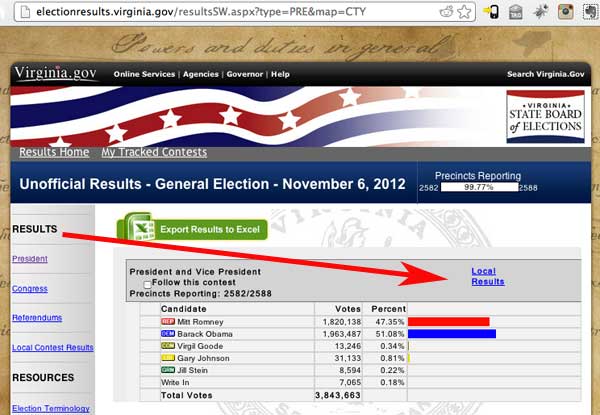Today I had the intro news writing class go to the Virginia State Board of Elections website and look up the election results for our college town (a small independent city, actually), then compare the results back in their hometowns and post short blog entries about the differences…
First complication — while the electionresults.virginia.gov page has a menu on the left, the actual link for local results in the national election is floating over on the right. (I added the red arrow to this snapshot.)

At first glance, I didn’t see the Local Results button on the right. The similarly named “Local Contest Results” item in the main menu is just for communities that had municipal elections on the same ballot.
(Some students preferred to let Google lead them to national news organizations’ versions of the results. We’ll compare those sources on Wednesday.)
I’d also like everyone to add links to the official sites for those communities so that we can see any characteristics of the communities that might have contributed to the voting total.
We were a little pressed for time Monday and will wrap that up on Wednesday. We’ll also look at U.S. Census Bureau data on the state and its communities (particularly Radford), and the Radford results by precinct.
Something looks interesting on that precinct display, and I’m going to ask the students whether they think there might be a story in it. In preparation, I wrote to Tracy Howard, the city’s registrar of voters, and asked for precinct boundaries or a map… Here’s some of the information he sent, starting with a link to the city’s Geographical Information System page:
http://radfordgis.radford.va.us/RadfordMap/
They are buried in the Governmental layers, and may be accessed there.
Turn on Govt. layer, then check voting districts.
If you have problems with access or can’t make it work:
- The East precinct is Everything in the City East of Connelly’s Run creek, from Rock Rd to the River.
- The Central precinct lies between Connelly’s Run and Staples St. along Staples to Rock Rd, then West along Rock Rd 700’ South up the mountain to include all of Charmont Dr. and Wild Partridge Lane. Then South to the Interstate.
- The west precinct is the remainder of the city west and south to the interstate.
As food for thought, here’s a pre-election New York Times blog post by election statistics whiz Nate Silver, who interviewed Geoffrey Skelley (@geoffreyvs), a political analyst at the UVa Center for Politics.
You also can zoom into this state election results map at Politico. (When you get there, click on the small blue dot that is Roanoke, the tinier blue dot that is Radford, and compare the neighboring Montgomery County, which includes Blacksburg.) There’s a similar map on The New York Times politics page, zoomed in to Virginia here.
